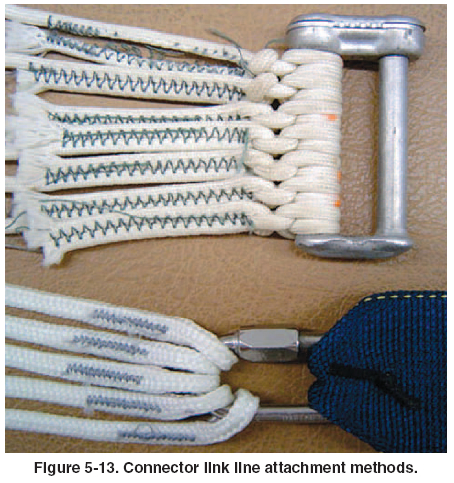Chapter 5
SUSPENSION LINES AND CONNECTOR LINKS
1. The lines, their attachment points, and the associated
stitching should be checked for damage or missing
stitches. With the older sheath and core nylon lines such
as Ty-III found on military surplus canopies, the zigzag
stitching at the links are prone to raveling. The more
modern noncontinuous line canopies use Dacron® or
nylon braided lines. The common attachment at the links
for these lines uses the “finger-trap” method to secure the
lines to the link, with a bar tack securing the lines. Most
manufacturers now use a contrasting color thread for the
bar tack in order to make inspection easier. Make sure all
bar tacks are in place. Figure 5-13 shows both methods of
line attachment to the links.
2. There are three basic types of separable connector
links in common use today for round canopies. They are
the standard “L” bar type, MS-22002; the Navy speed link, MS-22021; and the Quick link, commonly called the
Maillon Rapide® link, named after the French company
that first manufactured them. [Figure 5-14] The older military
surplus canopies are usually found with the two
types of MIL-SPEC connector links. Modern sport
canopies usually are found with the Rapide® links
because of their compatibility with the modern low bulk
suspension lines.
 
3. With the MIL-SPEC links, check the tightness of the
screws that hold the links together. With the speed links,
make sure the knurled side of the end cap is facing up and
the plates face outboard on the riser. The screw should
be checked for tightness at each repack.
4. If the canopy is equipped with Rapide® links, they
should be oriented on the riser with the barrel inboard and
to the bottom so it tightens upward. The link should be
tightened hand tight, then approximately one quarter turn
further. The actual force recommended for a number 5
link is approximately 30 foot-pounds. Most riggers do not
possess the force gauge to measure this, so they use the
quarter turn guide. After tightening the links, a “telltale”
should be applied to the barrel. [Figure 5-15] A telltale is
a marker, usually nail polish, that provides a breakable
seal to show if the barrel has moved. If the seal is broken,
the rigger knows the link may be loose. In doing a repack,
if the telltale is intact, the rigger should not loosen the
link and retighten it because continual tightening can strip
the threads, causing the link to fail.
| 
